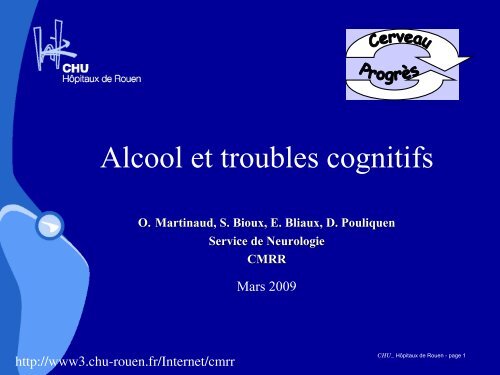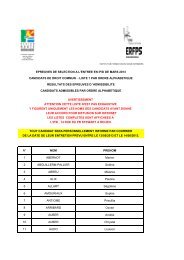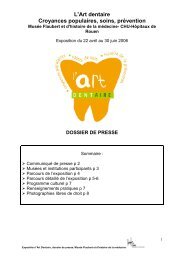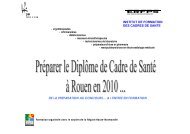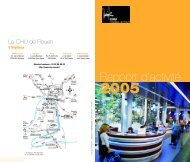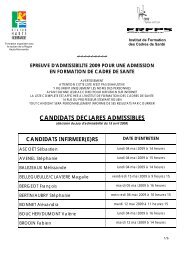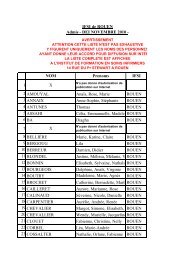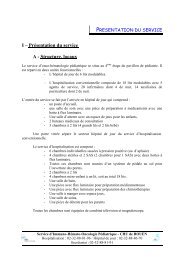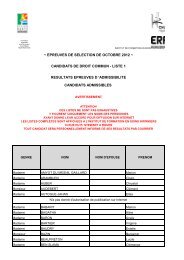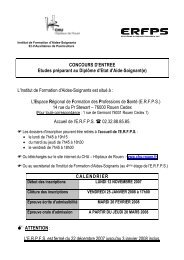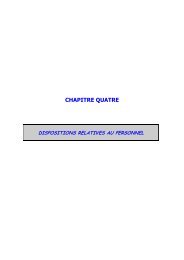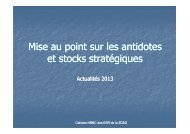alcool - CHU de Rouen
alcool - CHU de Rouen
alcool - CHU de Rouen
You also want an ePaper? Increase the reach of your titles
YUMPU automatically turns print PDFs into web optimized ePapers that Google loves.
Histoire <strong>alcool</strong>iqueEvaluation <strong>de</strong> la durée et <strong>de</strong> l’importance <strong>de</strong>l’intoxication <strong>alcool</strong>iquePremier contact avec l’<strong>alcool</strong>Début <strong>de</strong> la dépendanceDurée <strong>de</strong> la dépendanceConsommation habituelleNombre <strong>de</strong> sevrageDurée abstinencehttp://www3.chu-rouen.fr/Internet/cmrr<strong>CHU</strong>_Hôpitaux <strong>de</strong> <strong>Rouen</strong> - page 4
Conséquences Alcoolisme ChroniqueAtrophie cérébelleuseMarchiafava-BignamiDéficit cognitif pouvant aller jusqu’à la démenceEncéphalopathie <strong>de</strong> WernickeSyndrome <strong>de</strong> Korsakoffhttp://www3.chu-rouen.fr/Internet/cmrr<strong>CHU</strong>_Hôpitaux <strong>de</strong> <strong>Rouen</strong> - page 5
Marchiafava-BignamiEttore Marchiafava 1847-1935http://www3.chu-rouen.fr/Internet/cmrr<strong>CHU</strong>_Hôpitaux <strong>de</strong> <strong>Rouen</strong> - page 6
Marchiafava-BignamiAffection très rarePrincipalement chez éthyliques chroniquesSexe masculin, entre 50 et 70 ansLésion anatomique caractéristique : démyélinisationavec ou sans nécrose du corps calleuxManifestations :Démence progressive rapi<strong>de</strong>Epilepsie, astasie-abasie, dysarthrieDysconnexion calleuse ( apraxie <strong>de</strong> la main gauche,anomie <strong>de</strong> la main gauche, agraphie main gauche, apraxieconstructive main droite, apraxie diagonistique )http://www3.chu-rouen.fr/Internet/cmrr<strong>CHU</strong>_Hôpitaux <strong>de</strong> <strong>Rouen</strong> - page 7
Imagerie et MarchiafavaAnomalies diffuses <strong>de</strong> la substance blanche,démyélinisation avec nécrose du corps calleux;mieux visibles en IRMhttp://www3.chu-rouen.fr/Internet/cmrr<strong>CHU</strong>_Hôpitaux <strong>de</strong> <strong>Rouen</strong> - page 8Uchino et al., Eur Radiol 2006
Troubles cognitifs et <strong>alcool</strong>http://www3.chu-rouen.fr/Internet/cmrr<strong>CHU</strong>_ Hôpitaux <strong>de</strong> <strong>Rouen</strong> - page 9
Troubles cognitifs et <strong>alcool</strong>Atteintes : Mémoire / FE / visuo-spatialPas <strong>de</strong> répercussions sur l’autonomiePas <strong>de</strong> troubles du langage <strong>de</strong> type aphasiqueSi sevrage récupération possibleSi rechute accentuation troubles!Pitel et al., 2006http://www3.chu-rouen.fr/Internet/cmrr<strong>CHU</strong>_Hôpitaux <strong>de</strong> <strong>Rouen</strong> - page 10
Démence <strong>alcool</strong>iqueAlcohol-Related Dementia (ARD)http://www3.chu-rouen.fr/Internet/cmrr<strong>CHU</strong>_Hôpitaux <strong>de</strong> <strong>Rouen</strong> - page 11
Critères diagnostics démence <strong>alcool</strong>ique Syndrome démentiel- > 60 jours <strong>de</strong> l’arrêt <strong>de</strong> l’intoxication Consommation- Fixe, hebdomadaire, 5 ans- Persistante 3 ans avant début <strong>de</strong>s troubles Eléments supplémentaires- Signes cliniques ou paracliniques d’<strong>alcool</strong>isation, ataxie,polyneuropathie- Atrophie cérébelleuse (vermienne+) à l’imageriehttp://www3.chu-rouen.fr/Internet/cmrr<strong>CHU</strong>_Hôpitaux <strong>de</strong> <strong>Rouen</strong> - page 12Oslin et al., Int J Geriatr Psychiatr 1998
Imagerie démence <strong>alcool</strong>ique (ARD) Atrophie cérébelleuse (vermis+) corticale diffuse (nonspécifique)http://www3.chu-rouen.fr/Internet/cmrr<strong>CHU</strong>_Hôpitaux <strong>de</strong> <strong>Rouen</strong> - page 13Seitz et al., Alcohol Clin Exp Res 1999
Démence <strong>alcool</strong>iqueAtteintes : Mémoire / FE / visuo-spatialRépercussions sur l’autonomiePas <strong>de</strong> troubles du langage <strong>de</strong> type aphasiqueSi sevrage stabilisation voire récupérationPierruchi-Lagha et al., 2003http://www3.chu-rouen.fr/Internet/cmrr<strong>CHU</strong>_Hôpitaux <strong>de</strong> <strong>Rouen</strong> - page 14
Encéphalopathie <strong>de</strong> Wernickehttp://www3.chu-rouen.fr/Internet/cmrr1848-1904.<strong>CHU</strong>_Hôpitaux <strong>de</strong> <strong>Rouen</strong> - page 15
Encéphalopathie <strong>de</strong> Wernicke 29% nystagmus, paralysie VI, regard conjugué 23% ataxie, troubles <strong>de</strong> l’équilibre 19% aucun <strong>de</strong>s 3 signes (début) Causes (déficit en vitamine B1) <strong>alcool</strong>; malnutrition;chirurgie gastrique; diarrhées chroniques, vomissementsitératifs; cancers et chimiothérapies; SIDAhttp://www3.chu-rouen.fr/Internet/cmrr<strong>CHU</strong>_Hôpitaux <strong>de</strong> <strong>Rouen</strong> - page 16Sechi et Serra, Lancet Neurol 2007
Imagerie et Wernicke IRM T2Hypersignaux symétriques <strong>de</strong>s <strong>de</strong>uxthalami médians et <strong>de</strong> la substancegrise périaqueducale dumésencéphaleSe 53%; Sp 93%http://www3.chu-rouen.fr/Internet/cmrr<strong>CHU</strong>_Hôpitaux <strong>de</strong> <strong>Rouen</strong> - page 17Sechi et Serra, Lancet Neurol 2007
Syndrome <strong>de</strong> Korsakoffhttp://www3.chu-rouen.fr/Internet/cmrr1853-1900.<strong>CHU</strong>_Hôpitaux <strong>de</strong> <strong>Rouen</strong> - page 18
Syndrome <strong>de</strong> KorsakoffInstallation brutale (Suite GW)Trouble M. Épisodique ++++Oubli à mesureDésorientation spatio-temporelleRelative préservation <strong>de</strong>s capacités intellectuellesConfabulations et fausses reconnaissancesChangement comportementalAnosognosiehttp://www3.chu-rouen.fr/Internet/cmrr<strong>CHU</strong>_Hôpitaux <strong>de</strong> <strong>Rouen</strong> - page 19
Syndrome <strong>de</strong> Korsakoff et MémoireMémoire <strong>de</strong> travail :Normale (Bad<strong>de</strong>ley & Warrington, 1970)Boucle phonologique, calepin visuo-spatial et bufferépisodique – (Pitel et al, 2008)Administrateur centralEmpans <strong>de</strong> chiffres Empans multimodaux Empans visuo-spatiauxBoucle phonologique Buffer épisodique Calepin visuo-spatialVerbale Mémoire à long terme Visuellehttp://www3.chu-rouen.fr/Internet/cmrr<strong>CHU</strong>_Hôpitaux <strong>de</strong> <strong>Rouen</strong> - page 20
Syndrome <strong>de</strong> Korsakoff et MémoireMémoire épisodique :Antérogra<strong>de</strong> :Problème d’encodage <strong>de</strong>s faits et du contexte spatiotemporel(Pitel et al, 2008)Problème <strong>de</strong> consolidation (Meu<strong>de</strong>ll et al., 1979;Moscovitch, 1982)Problème <strong>de</strong> récupération (Warrington and Weiskrantz,1970)Rétrogra<strong>de</strong> :+/- étendu, suit un gradient temporelhttp://www3.chu-rouen.fr/Internet/cmrr<strong>CHU</strong>_Hôpitaux <strong>de</strong> <strong>Rouen</strong> - page 21
Syndrome <strong>de</strong> Korsakoff et MémoireMémoire sémantique :Préservation <strong>de</strong>s connaissances antérieurementacquisesAcquisition <strong>de</strong> nouvelles connaissances ?(Pitel et al., 2009)Mémoire procédurale :Préservation <strong>de</strong>s connaissances antérieurementacquisesAcquisition <strong>de</strong> nouvelles connaissances possiblemais + lentehttp://www3.chu-rouen.fr/Internet/cmrr<strong>CHU</strong>_Hôpitaux <strong>de</strong> <strong>Rouen</strong> - page 22
Syndrome <strong>de</strong> Korsakoff et F.E.Atteinte hétérogène selon les épreuvesSyndrome dysexécutif :Korsakoff <strong>alcool</strong>ique non korsakoff(Pitel et al, 2008)Changement comportemental :Apathie, manque d’initiativeEmoussement affectifDésinhibitionImpulsivité, irritabilitéhttp://www3.chu-rouen.fr/Internet/cmrr<strong>CHU</strong>_Hôpitaux <strong>de</strong> <strong>Rouen</strong> - page 23
Syndrome <strong>de</strong> Korsakoff et Confabulations« falsification <strong>de</strong> la mémoire qui intervient sanstroubles <strong>de</strong> la conscience et en association avecune amnésie d’origine organique » Berlyne, 1972Différentes interprétations mais pas <strong>de</strong> consensus :Réponse pour combler une mémoire défaillanteRésultat : amnésie + syndrome dysexécutifConfusion dans l’ordre temporel <strong>de</strong>s informationsSchni<strong>de</strong>r, 2000http://www3.chu-rouen.fr/Internet/cmrr<strong>CHU</strong>_Hôpitaux <strong>de</strong> <strong>Rouen</strong> - page 24
Syndrome <strong>de</strong> Korsakoff et ConfabulationsKorsakoff :Confabulations cohérentes et plausiblesSymptôme non obligatoireConfabulations provoquées :Fréquentes ++Confabulations spontanées :Disparition après phase <strong>de</strong> confusion Gayet-WernickePersistance en lien avec dysfonctionnement frontal(Gilboa et al., 2006)http://www3.chu-rouen.fr/Internet/cmrr<strong>CHU</strong>_Hôpitaux <strong>de</strong> <strong>Rouen</strong> - page 25
Syndrome <strong>de</strong> Korsakoff et ConfabulationsBatterie <strong>de</strong> confabulation (Dalla Barba, 1993 ;Dalla Barba et al, 1997)Questions <strong>de</strong> sémantique autobiographiqueQuestions <strong>de</strong> mémoire épisodiqueQuestions <strong>de</strong> sémantique non-autobiographiqueQuestions projets personnelsQuestions d’orientationDistracteurs épisodiquesDistracteurs sémantiqueshttp://www3.chu-rouen.fr/Internet/cmrr<strong>CHU</strong>_Hôpitaux <strong>de</strong> <strong>Rouen</strong> - page 26
Causes du syndrome <strong>de</strong> KorsakoffAtteinte <strong>de</strong>s corps mamillaires : suit souvent une encéphalopathie <strong>de</strong>Wernicke tumeurs <strong>de</strong> la base TC AVC séquelles <strong>de</strong> neurochirurgie.http://www3.chu-rouen.fr/Internet/cmrr<strong>CHU</strong>_Hôpitaux <strong>de</strong> <strong>Rouen</strong> - page 27
Imagerie du syndrome <strong>de</strong> Korsakoff IRMAtrophie <strong>de</strong>s corps mamillaireshttp://www3.chu-rouen.fr/Internet/cmrr<strong>CHU</strong>_Hôpitaux <strong>de</strong> <strong>Rouen</strong> - page 28Charness, Alcohol Clin Exp Res 1993
Évolution Korsakoff Evolution classique : 25% pas <strong>de</strong> récupération,25% récupération légère, 25% significative, 25%complète (McIntosh et Chick, JNNP 2004) Mais données discordantes : suivi <strong>de</strong> 20 patientsKorsakoff sur 2 ans sans évolution (Fujiwara etal., 2008)http://www3.chu-rouen.fr/Internet/cmrr<strong>CHU</strong>_Hôpitaux <strong>de</strong> <strong>Rouen</strong> - page 29
Prise en charge Traitement URGENT par thiamine (vitB1) :- 500mg par voie parentérale (sur 30mns) 3x/jpendant au moins 2-3j- puis 250mg/j pendant 3-5j (ou tant qu’il existeune amélioration); voie orale encore très discutée; ±vitPP justifié <strong>de</strong>vant toute encéphalopathie <strong>de</strong> natureindéterminée Risque <strong>de</strong> réaction anaphylactique (mais seulement4/millions d’IV ou 1/5millions d’IM) Sevrage en <strong>alcool</strong> ± rééducationhttp://www3.chu-rouen.fr/Internet/cmrr<strong>CHU</strong>_Hôpitaux <strong>de</strong> <strong>Rouen</strong> - page 30


